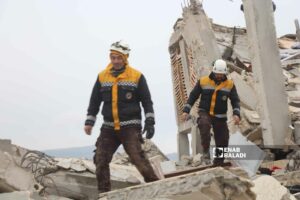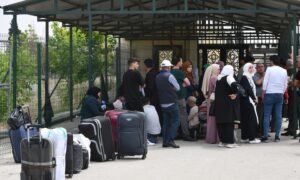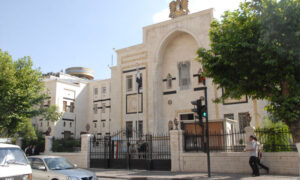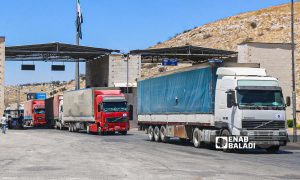Sleeping on the Edge of a Sword
Sleep deprivation in Syria’s prisons
By Mansour Omari
Detainees in Syria use many expressions that we do not usually use in our daily life. As a matter of language, these expressions have become almost exclusive for the prison cells and the underground space. These are words, which they have coined from the womb of their suffering, to have, thus, the best configuration and a succinct manifestation, for they are formed without effort, without revision or rhymes.
These words are also detained, just like their owners.
“Fasal” or “DISCONNECTED”, which means that the detainee is detached from reality and is unable to eat or communicate with the people around him/herself is a state that results from the primary shock of the barbarian method of detention, then brutal torture, and finally sleeplessness.
There is also the word “tasiīf” derived from the Arabic word for a sword, “saīf” which the detainees use to describe the way through which they are forced to sleep in the detention centers of the Syrian regime, because the cells strive with unreasonable numbers of detainees.
In this position, the detainees must sleep on their side not their backs, like a sword laid straight on its edge. The simile has a lot in common with sleeping on the edge of a sword, for your shoulder and arm get numb. And when you wake up, you feel as if the side of your body has become paralyzed.
The detainees are subjected to one of the most brutish torture techniques that affect both the body of the person and his/her mind even though the detainees are not fully aware that this technique is a practiced and a systematic approach. Many human rights organizations and activists do not even pay enough attention or conduct sufficient studies concerning this barbarous method.
Sleep Deprivation during Investigations
Sleep deprivation reduces cognitive abilities and comprehension and weakens the immune system, increasing susceptibility to infection, skin lesions and irregular heartbeat; it may also lead to death.
Psychologists say that sleep deprivation manipulates the cognitive abilities, controlled by the prefrontal cortex of the brain, and inadvertently engenders false memories. This is what officers/detectives use while investigating their victims. The sleep deprivation-based investigation often compels the victims to admit false and coherent memories, generated by fragments of the real ones, or triggered by the officer’s suggestions, inquiries or gestures.
This was the method adopted by the officers in Mezzeh Air Force Intelligence Branch, for instance. They subject detainees to shabiḥ-style torture- where a detainee’s hands are tied in painful positions- and deprive them of sleep by beating and sprinkling them with water while he/she are hanged. After this, the detainee is taken to an officer to complete the investigation process. Many detainees informed me that officers used to say to them: “I do not buy your story. I want you to make me believe it; I want it to be more coherent and spontaneous so I stop torturing you.”
Then he calls the torturer on to ask him to continue the process of torture.
Sleep Deprivation Persists for the Whole Duration of Detention
In the Branches/Detention Centers, the Chief Officer knows how many detainees he has got, the number of the cells, and the area of each cell, through reports placed on his desk every morning.
Despite this, they fill the cells with illogical numbers or, let us say, hard to believe by those who never experienced detention before.
For example, in Mezzeh Air Force Intelligence Branch, the number of the detainees reached twenty people in two meters long and one and a quarter meters wide solitary cell.
This compelled the detainees to take turns, standing up for hours, then squatting, and without ever lying down, the thing which deprived them of sleep, almost completely.
As for the collective cells, such as the ones in the Air Force Intelligence Branch or the Forth Division, the number of detainees swung between 70 to 90 people in a 8 meters long and 7 meters wide cell.
This allowed them to lay down, but they had to stand up in turns and sleep on their sides not on their backs. In the further crowded cells, detainees adopt the TRAIN approach, in which a detainee places his/her back between the legs of the detainee behind him/her, repeating the pattern to, finally, form a human chain, that in its connectedness resembles the train wagons.
In all the previously mentioned sleep positions, the detainee does not get a full hour sleep, for his/her turn might come to a halt; or one of the other detainees, accidently, might step on any part of the sleeping body to wake it; or the person against whom the detainee is placing his/her back might move…
According to Article Seven of the Rome Statute of the International Criminal Court for the year of 1998, which the Syrian Government has signed, “torture is a crime against humanity [. . .] when committed as part of a widespread or systematic attack directed against any civilian population, with knowledge of the attack.”
This definition applies to the arrest campaigns, detaining large numbers of civilians in insufficient spaces, and torturing them under inhumane conditions, which the Syrian regime has began since 2011 and continues to practice to the day of writing this article, for more than 100 thousand detainees are locked in the dungeons of Assad’s regime, where they suffer from sleep deprivation, as one of the many torture styles, which the Syrian regime is using against people.
if you think the article contain wrong information or you have additional details Send Correction
النسخة العربية من المقال
-
Follow us :
Most viewed
- Al-Hijri escalates against Damascus: A "radical" government
- Kurdish rejection and international welcome for Syria’s constitutional declaration
- Al-Sharaa signs draft constitutional declaration
- Turkey confirms continuation of its operations in northeastern Syria
- Governor of As-Suwayda signs understanding agreement with al-Hijri: Key details unveiled

















 A
A
A
A
A
A








 More Opinion
More Opinion